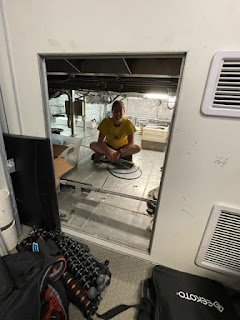Dragonflies
My favorite thing about the South is the bugs. No, I'm not talking about the mosquitoes that swarm around your head or the flies whose bites hurt as much as they itch. I'm talking about lepidopterans. I'm talking about coleopterans. I'm talking about arachnids. You know - arthropods. There is such incredible biodiversity in the southern United States.
Dozens of dragonflies flitted around the ship. Their long, needle-thin bodies gleamed and glimmered in the sunlight. A brown-and-white-striped spider darted out from under a box and caught a moth to munch on. A beetle climbed the side of the ship as I ascended the ladder. A large grasshopper rested atop the bow spotlight at dusk.
 |
| MV Sea Scout in Amelia, LA. Photo by Calvin Mires. |
Mobilization for any cruise is a big undertaking. You have to load everything that's needed for the research, for safety, and for supporting human life onto the ship. That covers everything from robots to groceries. If it's not on the ship when you leave port, you'll have to do without it until you get back. Beyond just loading, mobilization is also about making things work. Does the ship's generator provide the right kind of electricity to run the ROV? How will you carry the video feed from the control van to the lab and to the bridge? Where will the scientists do their lab work? How will all the data be backed up and transferred to shore? There are a lot of complicated logistical questions to be answered.
Probably the biggest question mark in our mobilization was how to lower the ROV into the water. Sea Scout has two A-frames - tall triangular structures used for lifting gear over the side. We settled on using the smaller A-frame on the ship's starboard side for the ROV, but that meant it needed a few extra metal pieces welded on to support the necessary pulleys. I'll spare you the play-by-play and just share the highlights: we had welders on the ship from 7 am to 7 pm, we had to shut off the ship's power for two hours, and a piece of solid steel got bent and had to be remade before the day was over. But hey, the A-frame works now.
At this point, I should probably explain that Sea Scout is not normally a research vessel, and the ROV we're using (from Reliant Robotics) is not usually used for science either. On the Gulf coast, oil is king, and marine operations companies spend most of their time in service of the oil and gas industry - surveying new areas of the seafloor or monitoring existing pipelines. We're stretching our own experience, too - I've never been on a survey ship like this before. The original plan was to use research assets, but fate intervened. Both the ship and the ROV we had lined up experienced significant technical issues, so we changed platforms mid-stream. That led to a lot of last-minute decisions and complicated logistics. I have a very good feeling about our ship and our ROV now that we're here, but we still have to see how things turn out.
 |
| Gleeful scientist in her orlop. Photo by Calvin Mires. |
Oh my gosh, you guys, the crawl space was so cool - like a hobbit hole with an aluminum floor. Calvin, ever the archaeologist, peeked in to see what I was doing and immediately announced the I had found an orlop - a deck between decks. Apparently they were made famous by the Swedish warship Vasa, which had a number of them. There you go, friends: orlop - your vocabulary word for the day.
By nightfall, we still weren't done with everything, but we decided we could figure out the rest on the way. We left port around midnight and headed to our first study site. Oh man, I hope we get data!
Comments
Post a Comment